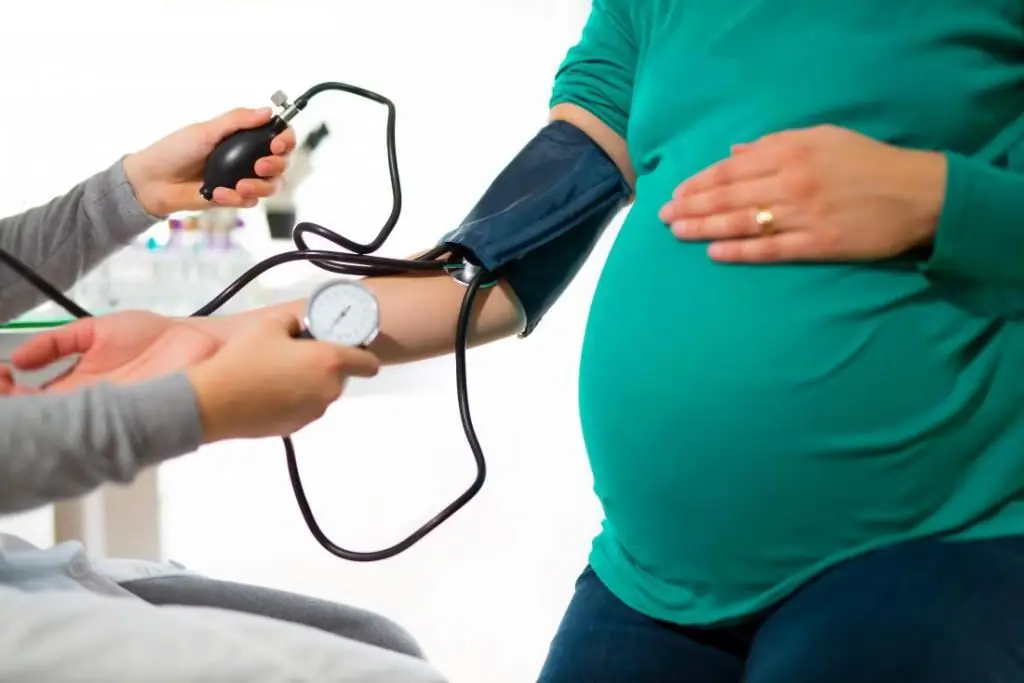2026 Author: Priscilla Miln | [email protected]. Last modified: 2025-01-22 17:55:13
Any medical manipulation during childbearing instills doubts in women. Hence, upon receiving the next referral, the question arises: is it possible to do an ECG during pregnancy? Women can be understood, because recently they have become responsible not only for their lives, but also for the life of their child. Therefore, even such a harmless procedure as an ECG during pregnancy requires a serious and deliberate approach.
What is an ECG?
Electrocardiography is a method of studying the electrical fields that are formed as a result of the work of the heart. The abbreviation ECG stands for "electrocardiogram", which, in turn, is a printout obtained from the study of the heart muscle.

The ECG procedure is a fairly inexpensive, but very informative diagnostic method in cardiology. It is carried out with the help of special devices, which, receiving impulsesthrough electrodes, write them down on thermal paper. Modern electrocardiographs allow you to immediately save the ECG of patients in digital form without printing.
What diseases can be detected with an ECG?
Electrocardiography allows you to identify many diseases and pathologies of the heart. It is prescribed for routine medical examinations, as well as in early pregnancy. ECG may reveal:
- Impaired intracardiac patency.
- Diseases associated with abnormal heart rate (arrhythmia, extrasystole).
- Myocardial injury.
- Disorders of electrolyte metabolism (potassium, calcium, etc.).
- Some non-cardiac diseases, such as obstruction of the pulmonary artery.
- Acute cardiac pathologies.

As a rule, electrocardiography is included in the mandatory list of studies during clinical examination. In addition, an ECG during pregnancy may be prescribed unscheduled if the woman has indications for this procedure.
Indications
During pregnancy, a woman's heart muscle begins to work with a vengeance. This is due to the fact that oxygen saturation and useful substances of the fetus occurs through the blood. In addition, during this period, the level of hormones increases, which also affect the functioning of the heart.
ECG during pregnancy is usually prescribed in the first trimester. It is on the list of recommended studies, especially if:
- a woman has constant jumps in blood pressure;
- there are complaints aboutsharp or dull pain in the region of the heart;
- pregnant suffers from headaches, dizziness, fainting;
- there are pathologies of pregnancy (polyhydramnios, preeclampsia, etc.)

Throughout the entire period of pregnancy, he althy women undergo electrocardiography once. There are no contraindications for recording an ECG during pregnancy, so it is assigned to absolutely all women who are registered with a he althcare facility.
Preparing for ECG
As with any procedure, it is advisable to prepare for electrocardiography. This is necessary to quickly and easily pass the study without the need to re-enroll.
Recommendations for ECG preparation:
- For the procedure, it is better to choose clothes that can be easily unfastened on the chest.
- On the appointed day, creams and other cosmetics should not be applied to the skin, as they can disrupt electrical conductivity.
- There should be no chains, pendants or other decorations in the décolleté area that will interfere with fixing the electrodes.
- Immediately before the study, you need to tell the doctor about all the medications that are currently being used, especially heart medications.

Also, if a woman is going to have an ECG during pregnancy, she should avoid strenuous exercise immediately before the procedure. Therefore, when climbing the stairs to the office, there is no need to rush. But if, nevertheless, before entering the electrocardiographythere is shortness of breath, rapid pulse due to physical fatigue, you need to sit for a while and wait until the heart rate is restored and returns to normal.
How is an ECG done during pregnancy?
Electrocardiography is carried out in he althcare facilities - clinics, hospitals, medical centers. Today, there are portable devices with which a doctor can record an ECG even at home. However, for now, they are only used for patients who are unable to get to a medical facility on their own.
The standard ECG procedure is as follows:
- The patient exposes the area of the chest, forearms, shins and fits on a special couch.
- The doctor applies a gel to the indicated areas, which reduces electrical resistance.
- Electrodes are attached to special points on the body, where the highest electrical conductivity. During the examination, they will transmit impulses to the device, which will translate them into a graphic image.
- During recording, the patient should breathe calmly and evenly. The doctor may ask you to take a deep breath and hold your breath for a while. The patient must follow the instructions in silence as talking during the ECG is not allowed.
- To make the ECG as informative as possible, the patient's body must be at rest. Movement and even involuntary shaking can blur real ECG results.
- After the recording is completed, the electrodes are detached, the remains of the gel are wiped off the skin. The ECG result is transmitted to the doctor who gave the referral for the examination.

This procedure is quite simple. As a rule, it takes no more than 5-7 minutes. But the abundance of electrodes usually scares women and makes them doubt whether an ECG is possible during pregnancy.
Contraindications
Caring about the he alth and development of the child, before agreeing to medical examinations, women are primarily interested in the available contraindications. In the case of electrocardiography, there are none. Absolutely all doctors, including gynecologists, say that you can do an ECG during pregnancy, regardless of the patient's condition. The only side effect that may occur after the procedure is a rash in the places where the electrodes are attached. As a rule, this is an individual intolerance to the gel, which is used during the examination. However, such rashes are not dangerous. They go away on their own in 1-3 days.
Analysis of ECG results
Only a doctor can decipher the readings obtained after electrocardiography. For experienced specialists, this takes an average of 10-15 minutes, after which the ECG results are transmitted to the gynecologist who issued the referral for the examination.

The conclusion given on the basis of electrocardiography indicates:
- heart rate pattern;
- heart rate (HR);
- electrical axis of the heart muscle;
- presence or absence of conduction disturbances.
If the ECG was prescribed according to the available indications, then for settingdiagnosis, the doctor analyzes the totality of symptoms and signs of the disease. In the most serious cases, the patient may be hospitalized for a complete and thorough examination.
Features of cardiogram in pregnant women
During pregnancy, the nature of the cardiovascular system changes dramatically. She begins to work for two, and this, in turn, cannot but be reflected in the ECG. The difference is especially noticeable when examining women in the third trimester of pregnancy.
For the cardiogram of a pregnant woman is typical:
- Shift of the electrical axis of the heart muscle to the left.
- Increase heart rate.
- Reduce PR interval.
- Increase in the depth of the Q wave in the third lead and in all chest leads on the right.
- The T wave is made up of two leads, and it can also become both positive and negative.

These changes are explained by an increase in cardiac output, which is typical for pregnant women. This physiological feature arises from the need to ensure normal blood flow in the placenta and the fetus. Also, the features of the cardiogram in pregnant women are affected by weight gain and a shift in the position of the heart in the chest. Therefore, in order to avoid making an erroneous diagnosis, when deciphering the ECG, the doctor must take into account the position of the patient.
Recommended:
"Cycloferon" during pregnancy - is it possible or not? Instructions for use of the drug during pregnancy

The use of "Cycloferon" during pregnancy in the early stages helps to get rid of the symptoms of viral and infectious disorders. Human immunity is activated, a stable antimicrobial effect occurs. Tumor formation in the body slows down, autoimmune reactions are restrained, pain symptoms go away
"Sinupret" during pregnancy in the 3rd trimester. Instructions for use of the drug during pregnancy

Infection and inflammation are more pronounced when the body is weakened, so experts choose safe medicines. Used "Sinupret" during pregnancy. The 3rd trimester passes without serious complications if the infection can be overcome on time with the help of this medicine
Pain during urination during pregnancy: causes, possible deviations and diseases, treatment methods

Pain during urination in women during pregnancy is an unpleasant phenomenon, and in some cases dangerous to the he alth of the mother. After all, it is during the period of gestation that the female body is most vulnerable to various kinds of infections
Is it possible to treat teeth during pregnancy? The dangers of anesthesia during pregnancy

The age-old question - to carry out dental treatment during pregnancy or not? Many ladies, unfortunately, rarely pay attention to their oral cavity, but they should. Indeed, in the event of any dental disease, a focus occurs, rich in a wide variety of infections. And if no action is taken, the child suffers. Does he deserve such a fate?
Hypotension during pregnancy: possible causes, symptoms, treatment, normal pressure during pregnancy, advice and recommendations from a gynecologist

What is hypotension during pregnancy? Is it a simple ailment, or a severe pathology that requires immediate medical attention? That is what we will talk about today. During the period of bearing a baby, every woman is faced with various ailments, because the body works "in three shifts", and gets tired in order. At this time, chronic diseases are exacerbated, and "sleeping" ailments are awakened, which could not be suspected before pregnancy

